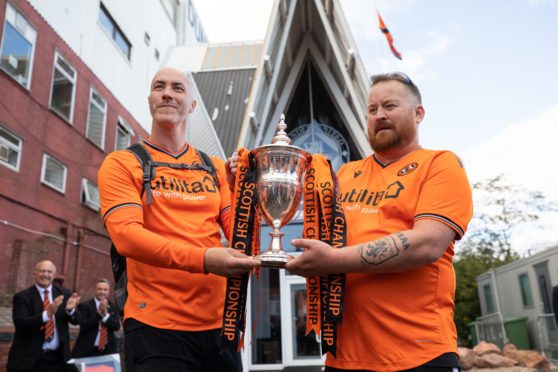The terrific fundraising effort of two Dundee United supporters to help with the legal bills for an arbitration process, which threatens the club’s Premiership status, is fan power at its best.
Their hike from Tynecastle to Tannadice has raised almost £46,000, with donations ending at midnight on Sunday.
It’s a heartening sight to see the current fusion between supporters and club.
For a spell, under previous stewardship, there was a deep discord which at times undermined the stability of everything that happened at Tannadice.
That has been subdued by the new owners and sporting director Tony Asghar who’ve invested heavily in time and money.
But they’ve also made clear that they will make the decisions, albeit with open fan engagement.
They’ve taken the right approach. The penalties for poor decisions rest with those running the club.
Their heads are on the chopping block if they get it wrong.
I’ve expressed admiration for supporter-owned clubs, but it’s no panacea to cure all the ills of the game and the often brutally tough decisions which need to be made.
Even at fan-owned clubs, democracy doesn’t extend to professional decision making.
With various supporters and groups helping out financially with capital projects for the youth setup, the club can build for the future.
However, it remains in the ownership of a private individual, with other small shareholders.
It’s not a democracy and that’s fair enough.
Those in charge have proven amenable to dialogue, setting up a body for supporters groups to meet club directors and discuss certain matters.
At Tannadice, the fans and club finally seem to be United once again.
Aberdeen is the latest Scottish club to feel the financial effects of the current pandemic, with a further £1 million to be saved through wage cuts.
I was on a podcast with new chairman Dave Cormack some weeks back and it seemed obvious then that he had inherited the club from Stewart Milne at the worst possible time.
Cormack is bursting with fresh ideas and a great community spirit for the Dons, but his first year in charge must have him shaking his head at the calamitous situation he finds himself in.
Aberdeen is a very well run club – if they can fall foul of an undreamt of financial crisis, so can anyone.
Birmingham City’s decision to retire their number 22 shirt after the wearer, 17-year-old Jude Bellingham, departed for Borussia Dortmund is either a fantastic PR stunt, or a completely crass decision that makes a complete mockery of the gesture.
Shirts have been retired before but for absolute legends that carved out glorious careers and contributed enormously to the sport of football.
Men like Bobby Moore, Franco Baresi, and Johan Cruyff have all had their shirts retired.
With all due respect to young Bellingham, they had given a lifetime’s service to the game, not a mere 44 matches with four goals.
If it’s a marketing stunt, then publicity is duly achieved but if it’s a dewy-eyed, ludicrously sentimental decision – which I suspect it is – then the club are a laughing stock.


